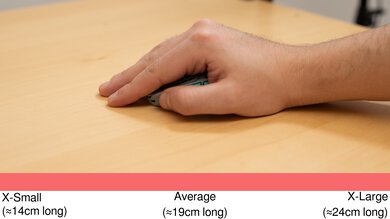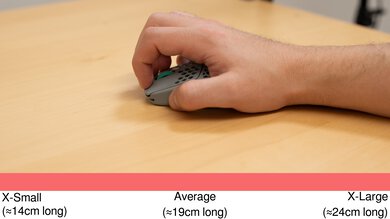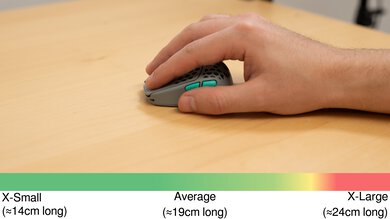The G-Wolves HSK Pro 4K is an extremely lightweight wireless gaming mouse that's part of G-Wolves' HSK Pro lineup of gaming mice. It has a plastic shell with honeycomb-shaped cutouts that help decrease its overall weight. It features an unconventional shape that's specifically designed for use with a fingertip grip. It also features PixArt's PAW3395 sensor and supports a maximum polling rate of 4000Hz out of the box or 8000Hz with the additional purchase of the G-Wolves 8k receiver.
Our Verdict
The G-Wolves HSK Pro 4K is an okay mouse for work, but it's not designed for this use. It's extremely small and only suitable for use with a fingertip grip, which might be uncomfortable for long periods. You can connect to it wirelessly using its included 2.4 GHz USB receiver, but it doesn't support Bluetooth or multi-device pairing. Its scroll wheel also lacks useful features like a free scrolling mode and L/R tilt inputs.
- Connects wirelessly with its 2.4Ghz receiver.
- Small size and shape only suitable for a fingertip grip.
- Doesn't support Bluetooth; no multi-device pairing.
- Scroll wheel lacks a free-scrolling mode and L/R tilt inputs.
The G-Wolves HSK Pro 4K is an outstanding mouse for FPS gaming. It's incredibly lightweight, making it nearly effortless to move accurately and precisely. It also has excellent performance, with remarkably low click latency and an accurate and precise sensor, resulting in a very responsive gaming experience. However, its unconventional shape is only suitable for a fingertip grip, so this mouse is not a good option if you use a claw or palm grip.
- Extremely lightweight.
Maximum wireless polling rate of 4000Hz or 8000Hz with the purchase of the separate 8k receiver.
- Incredibly low and consistent click latency performance.
- Excellent all-around sensor performance.
- Small size and shape only suitable for a fingertip grip.
Unusual 8000Hz implementation issues using the separately purchased 8k receiver.
Despite not being designed for this use, the G-Wolves HSK Pro 4K is good for MMO gaming. It has good build quality and excellent click latency and sensor performance. While you can remap its buttons using the customization software, it doesn't have nearly as many as dedicated MMO mice. Also, its unusual shape is only suitable for a fingertip grip, which might be uncomfortable for long gaming sessions.
- Extremely lightweight.
Maximum wireless polling rate of 4000Hz or 8000Hz with the purchase of the separate 8k receiver.
- Incredibly low and consistent click latency performance.
- Excellent all-around sensor performance.
- Small size and shape only suitable for a fingertip grip.
- Significantly fewer side buttons compared to dedicated MMO gaming mice.
Unusual 8000Hz implementation issues using the separately purchased 8k receiver.
The G-Wolves HSK Pro 4K has superb raw performance. It has outstanding click latency and an excellent sensor that's accurate and precise. It also supports a maximum polling rate of 4000Hz out of the box, delivering slightly more consistent performance over a standard 1000Hz polling rate. Following a post-launch firmware update, this mouse now also supports a maximum polling rate of 8000Hz with the separate purchase of the G-Wolves 8k receiver. Unfortunately, our Click Latency and Sensor Latency results suggest there may be an unknown issue with the implementation of 8k polling, resulting in worse performance.
Maximum wireless polling rate of 4000Hz or 8000Hz with the purchase of the separate 8k receiver.
- Incredibly low and consistent click latency performance.
- Excellent all-around sensor performance.
Unusual 8000Hz implementation issues using the separately purchased 8k receiver.
Changelog
- Updated Feb 05, 2025:
We've conducted additional Sensor Latency and Click Latency testing at an 8000Hz polling rate using the H-Wolves 8K dongle. However, our scores remain unchanged since this receiver is only available as a separate purchase.
- Updated Jun 11, 2024: We've mentioned the newly-reviewed Finalmouse ULX Pro Series in the Hand Size Recommendation section of this review.
- Updated May 16, 2024: We've added a link to the newly-reviewed Keychron M4 in the
- Updated May 10, 2024: We've fixed a typo in the sensor model.
Check Price
Differences Between Sizes And Variants
The G-Wolves HSK Pro 4K has several color variants: Grey+Red, Grey+Green, Pink, Black Pearl, Ruby Red, and two variants each of Sapphire Blue and Turquoise. We bought and tested the Grey+Green variant. G-Wolves also sells the HSK Pro ACE, which is virtually the same as the HSK Pro 4K but supports a lower maximum polling rate of 1000Hz.
This mouse doesn't have a label or serial number that's visible.
Popular Mouse Comparisons
The G-Wolves HSK Pro 4K is an ultra-lightweight wireless gaming mouse that's part of G-Wolves' HSK Pro lineup of mice. It has a very small shape that's designed to be used specifically with a fingertip grip type. It's about half the size of an average gaming mouse, meaning it's significantly lighter than most gaming mice, but it doesn't have the flexibility that others have since most are designed to suit a range of hand sizes and grip types. The Zaunkoenig M2K is another fingertip-only mouse, but it's wired and has been discontinued. The Keychron M4 is a new lightweight wireless gaming mouse that features a similar fingertip-only shape.
For other recommendations, see our picks for the best wireless gaming mice, the best FPS mice, and the best lightweight mice.
The Keychron M4 and the G-Wolves HSK Pro 4K are high-performance, lightweight, wireless gaming mice. They're both extremely small and designed to be used exclusively with a fingertip grip. While the two have similar shapes, the Keychron is noticeably longer but still very small. They both use the same sensor and have remarkable raw performance that's suitable for casual and competitive gaming. The Keychron has better build quality, a larger battery, and Bluetooth connectivity.
The G-Wolves HSK Pro 4K and the Zaunkoenig M2K are high-performance, lightweight gaming mice. They are both extremely small mice designed to be used with a fingertip grip only. The Zaunkoenig M2K is a wired-only model, and it lacks side buttons. It's also made of carbon fiber and has a maximum native polling rate of 8000Hz. On the other hand, the G-Wolves is wireless and supports a maximum native polling rate of 4000Hz (or 8000Hz with a separately purchased G-Wolves 8k receiver). It's also not as well made as the Zaunkoenig, and it's made of plastic instead of carbon fiber.
The Razer Viper V2 Pro and the G-Wolves HSK Pro 4K are high-performance, wireless gaming mice. The G-Wolves features an unconventional shape that's only suitable for a fingertip grip, but it's significantly lighter than the Razer. The Razer has a larger symmetrical shape suitable for various grip types and hand sizes.
The G-Wolves HSK Pro 4K and the Razer Viper Mini Signature Edition are extremely lightweight, high-performance wireless gaming mice. While the Razer has a more conventional symmetrical shape, the G-Wolves has a very small shape designed specifically for a fingertip grip. As a result, it's much lighter than the Razer. On the other hand, the Razer has much better build quality than the G-Wolves, and it's constructed using a lightweight magnesium alloy. The Razer also has lower sensor latency.
Test Results

This mouse has a matte plastic shell with honeycomb cutouts on the top and underside, exposing its internals and purple PCB. The unit we bought and tested is grey with a teal scroll wheel and side buttons. There's a small G-Wolves logo in front of the scroll wheel. It has no RGB lighting, but it has a singular status LED on its underside.
Note: The 3D scanning tool has difficulty capturing depth inside the mouse's honeycomb body. As a result, the scan displays a blurry texture inside the mouse, but the dimensions of the scan are still accurate.
The G-Wolves HSK Pro 4K has good build quality. To save weight, the body is made from smooth plastic with hexagonal cutouts in a honeycomb pattern. There's some flex in the body if you apply enough pressure, but it's not noticeable during normal use. If you push it to the right with intentional force, you can actuate the scroll wheel click. We discuss this issue more at length in the Mouse Wheel section later on.
If you're looking for a similarly small mouse with a more conventional solid plastic shell and better build quality, check out the Keychron M4.
This mouse is designed exclusively for a fingertip grip. It's about half as long as most traditional mice, leaving nowhere to support your palm for any other grip type. If you have large or extra-large hands, this mouse might be difficult to use due to its small size.
If you're looking for a mouse that's only slightly heavier but has a more conventional shape, check out the Finalmouse ULX Pro Series.
You can connect to this mouse wirelessly using its 2.4 GHz receiver. The included battery has a capacity of 130mAh. G-Wolves doesn't advertise a battery life estimate, but users online have reported getting around 9 hours of battery life at a 4000Hz polling rate and around 15 hours at a 1000Hz polling rate. The LED on the mouse's underside will flash when the battery is at or below 10%.
When using this mouse at an 8000Hz polling rate with the separately purchased G-Wolves 8K receiver, we estimate battery life to be under 9 hours, though we don't have a more precise measurement. If you've tested battery life yourself, we encourage you to share your experience in the comments.
The G-Wolves HSK Pro 4K includes a paracord-like micro-USB charging cable that's lightweight and flexible but retains some permanent kinks from its packaging.
Note: Although there's a visible bump in the pre-travel of the actuation graph, it's not noticeable in normal use.
We couldn't register a click more than 2cm from the front of the click button with our testing tool. However, the button will still register a click if you press it past 2cm from its front, but it's significantly heavier the further back you press the button.
This mouse has exceptionally low click latency. It provides an incredibly responsive experience for gaming in any genre and at any competitive level. We tested this mouse at 4000Hz polling, which is its maximum polling rate out of the box, and the lowest debounce setting of 0ms.
We also tested this mouse at a 1000Hz polling rate and found the results to be only marginally higher.
We performed supplementary testing at an 8000Hz polling rate with the G-Wolves 8k receiver, which is sold separately. Unfortunately, using an 8000Hz produces slightly higher and less consistent click latency. This is unexpected, but it coincides with equally unusual Sensor Latency results and signifies there may be an unknown issue with G-Wolves implementation of 8000Hz with this mouse.
This mouse has superb CPI performance. It tracks your movements accurately and precisely with very little variation. We conducted this test at the mouse's maximum polling rate of 4000Hz.
The G-Wolves HSK Pro 4K has excellent sensor latency performance. It reacts quickly to your movements and is suitable for casual and competitive gaming. We conducted this test at a polling rate of 4000Hz with Motion Sync turned off. These results, especially the delay at half movement and the delay to end of movement, are on the higher side of what's expected for a gaming mouse with a 4000Hz polling rate.
We also tested this mouse with Motion Sync turned on and at a polling rate of 1000Hz. You can see graphs for our results with the following settings:
The Motion Sync setting did not have a noticeable effect on sensor latency performance, but, unexpectedly, we observed that the position of the mouse cursor matches the physical position of the mouse more closely when we tested it at 1000Hz.
We measured similarly unusual performance with an 8000Hz polling rate using the G-Wolves 8k receiver, which is sold separately.
Unfortunately, while using an 8000Hz polling rate reduces 'Delay At Half' and 'Delay To End Of Movement,' it significantly increases 'Delay To Start.' This is unexpected but coincides with unusually high and inconsistent Click Latency results, suggesting a potential issue with G-Wolves' 8000Hz implementation on this mouse.
This mouse's available polling rate settings out of the box are 125Hz, 250Hz, 500Hz, 1000Hz, 2000Hz, and 4000Hz.
It also supports an 8000Hz polling rate with the separate purchase of the G-Wolves 8k receiver.
Like other mice using PixArt's PAW3395 sensor, this mouse features Motion Sync, a sensor setting that synchronizes sensor data with polling events. It can improve how closely your mouse movements are matched on-screen but can add around 1 ms of motion latency.
The G-Wolves HSK Pro 4K has a plastic scroll wheel with a grooved rubber coating. It has very well-defined steps and operates quietly.
You can actuate the middle mouse click button if you push the scroll wheel to the right. It takes a significant amount of pressure, so it's unlikely that you'll click it unintentionally. It's a somewhat commonplace issue found on many gaming mice. Some people don't mind or even prefer a mouse wheel with this functionality, but it's unclear if it's an intentional design decision.
This mouse's companion software allows you to adjust the wheel's scroll rate and scroll debounce. We experienced a strange behavior on our unit where if you set the scroll rate to 3 or higher, the scrolling speed slows down drastically if you scroll very quickly or flick the wheel. We were able to remedy this by changing the scroll rate setting to a value lower than 3. If you have this mouse and have experienced something similar, let us know in the comments.
The left- and right-click buttons, side buttons, and the scroll wheel operate very quietly and are unlikely to bother anyone around you.
This mouse has a very simple companion software that lets you change various settings like CPI, polling rate, lift-off distance, Motion Sync, and more. It's straightforward to use, but has some quirks, like requiring you to click "Refresh" to save your changes.































